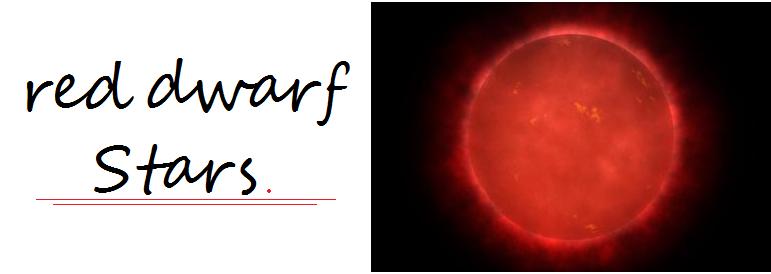
What is a Red Dwarf Star?
First off, stars are classified by two important things: Their temperature and their spectra which are the elements that they absorb. Therefore, there are seven types of classifications for stars. In order of decreasing temperature, O, B, A, F, G, K, and M.
The red dwarf could be in the classification of M or late K. Some characteristics that can determine this is the low mass, which is approximately in the range 0.1 to 0.5 solar mass. Their low surface temperature, in the range 2,500 to 3,500°C, having a red color and also being very faint. They are the most common type of stars. They survive longer and more numerous than any other type of star.
Research shows that there are about 263 "M" sequence stars located within 10 parsecs or 32.6 light years. The size of these stars can range from a hundred of times smaller than the sun to only a couple times smaller than the sun. Even though they are the most common stars, we rarely can spot them with our naked eye because they are so far away and so faint.These stars live so long because they burn very little fuel for such long periods of time. This in turn, could exhibit a trillion years life span for these stars. Their mass is so small they will never collapse enough to start a new cycle of activity.
Stars work like fire flames and usually, the hottest part of a flame is the blue part and the temperature vaires with color. The reason why the red dwarf has a faint red color that it is is because it is not that hot compared to other stars. Many young red dwarfs are flare stars with frequent and heavy eruptions, increasing their brightness enormously for a short time. Throughout their life span, red dwarfs are generated through nuclear fusion of hydrogen into helium at a slow rate. This in hand, causes the stars to emit light but can only emit as much as 1/ 10000 of the sun. Even one of the largest red dwarfs can be comparable to 10% of the suns luminosity.
The process of life for a red dwarf star.
In general red dwarfs transport energy from the core to the surface by convection which Convection occurs because of opacity. of the interior, which has a relatively high density compared to the temperature.

As red dwarfs are fully convective, helium does come together at the core and, compared to larger stars such as the Sun, they can burn a larger proportion of their hydrogen before leaving the main sequence.
As was said earlier, red dwarfs have estimated lifespans longer than the estimated age of the universe, and stars with less than 0.8 solar mass. The "solar mass" is the standard way to express mass in astronomy.

Possibility of life?
Red dwarfs make up about 75 % of the stars in the miky way. If we included them as candidates for attaining life, we'd have an extra 100 billion habitants alone.
But with red light photosynthesis it is more difficult and less effective.so if there were life on the planets that accommodated the stars, living conditions would be quite different. Planets that are near enough to get sufficient energy, are tidally locked which means that the star would always be on the same side. In this case, the planets would experience perpetual daylight and eternal night. This in hand, would create a temperature variation on different sides of the planet. This questions whether life could be sustained on such extrasolar planets but a couple theories have been suggested that a thick atmosphere and the oceans could potentiay circulate heat around the planet

There have been a few citing on whether such red dwarf stars are accommodated by their own planets.
In 2005, it was discovered that extrasolar planets were discovered orbiting the red dwarf named Gliese 581. It is a star located about 20.40 light years away in the constellation Libra. The planet had about the mass of Neptune. It orbits just 6 million kilometers or .04 AU and estimated to have a surface temperature of 150 degrees Celsius.
In 2006, a planet even smaller to the one last discovered which was 5.5 times the mass of earth was found orbiting the red dwarf named OGLE-2005-BLG-390L. It contains an estimated surface temperature of -225 degrees Celsius and is approximately 390 km from the star.



Comments (0)
You don't have permission to comment on this page.